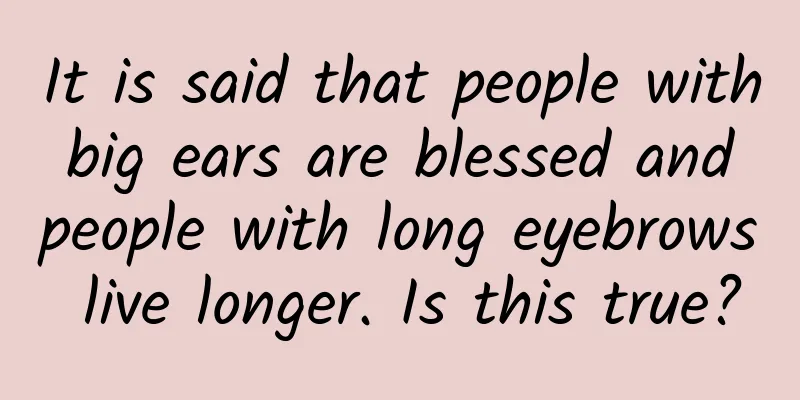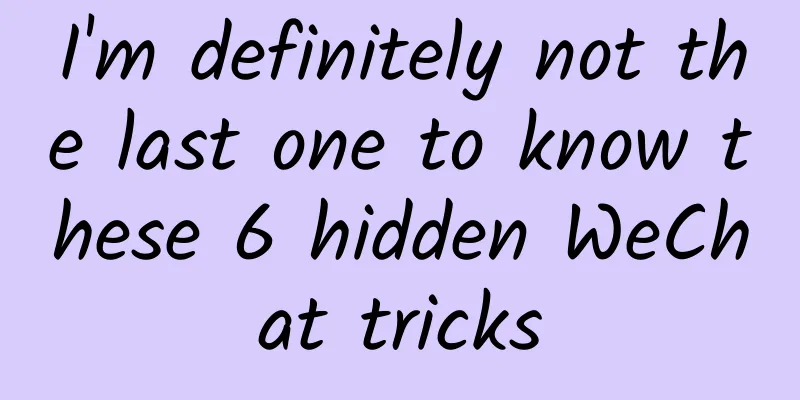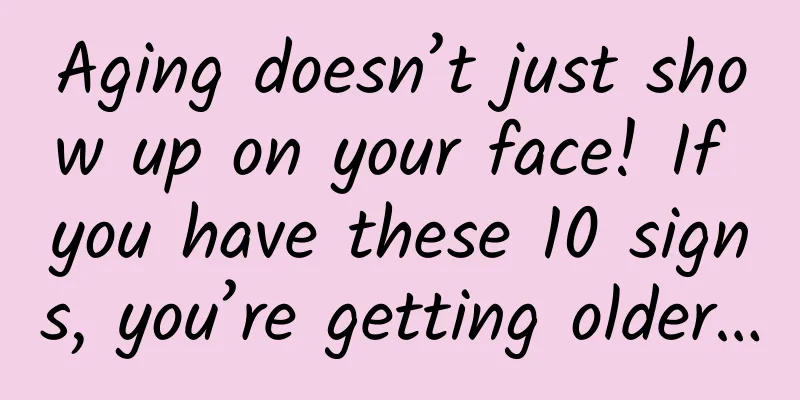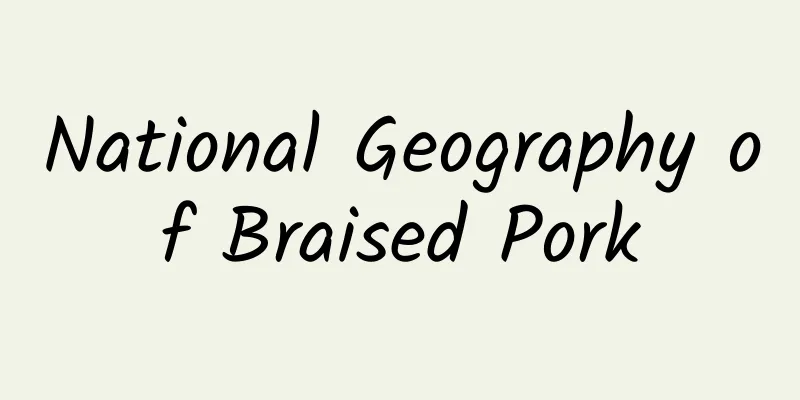It is said that people with big ears are blessed and people with long eyebrows live longer. Is this true?

|
Some time ago, there was a lot of discussion about the movie "The First Incense". Of course, the main characters were focused on the male and female protagonists, and few people discussed Mrs. Liang's two maids. The names of these two maids are quite special, they are Didi and Nier . What do they mean? Didi and Nier in the movie "The First Incense" Both 睇 and 睨 are radicals of the Chinese character 目, which are related to eyes, and both mean to look at something with the eyes slanted. In addition to eyes, ears and eyebrows in Chinese characters are also very particular. For example, it is often said that "big ears mean good fortune" and "long eyebrows mean longevity". Are these sayings reliable? Let's talk about them in detail today. 01 Why do people say that big ears bring good fortune? There is a saying that Confucius was named "Qiu" because his head was bumpy like a hill, and Lao Tzu, also a sage from the Pre-Qin period, was named "Li Er" because he had big ears. The "Laojun Rock" on Qingyuan Mountain in Quanzhou, Fujian, is a stone statue of Laozi from the Song Dynasty. The earlobes are carved very full and hang down to the shoulders. The word "ear" was originally a simple drawing of a human ear in oracle bone script during the Shang Dynasty. Later, it gradually changed into its current appearance. The above pictures show the word "耳" in oracle bone script from the Shang Dynasty (Figures 1 and 2), bronze inscription (Figure 3), large seal script from the Warring States Period (Figure 4), and small seal script (Figure 5). Li Er's character is "聃(dān)", which refers to big earlobes. The homonymous character "耽" also means big earlobes, which are so big that they hang down to the shoulders, which is derived from the meaning of bearing, and later also means being addicted. Another character that represents earlobes is "耴(yì)," and the small seal script of this character has a bit of pictographic meaning. Small seal script of word 耴 Adding "车" to the left side, it becomes "璋 (zhé)", which means the part of the ancient carriage that turns left and right - shaped like an ear, also known as "车耳". Gongsun Zhe, the grandson of Duke Mu of Zheng in the Spring and Autumn Period, used "子耳" as his courtesy name. According to folk physiognomy, big ears are a sign of good fortune, implying wealth and longevity. One explanation is that because the external ear grows throughout life, people who live long lives naturally have big ears, and the folk rumor is a reversal of cause and effect. The most famous historical figure with big ears is Liu Bei. The Records of the Three Kingdoms records that he "looked at his own ears", which means that his ears were so big that he could see them. This is definitely an exaggeration. In the Romance of the Three Kingdoms, Liu Bei is always called the "big-eared thief" by his opponents. In the TV series Romance of the Three Kingdoms, Ji Ling scolded Liu Bei as a big-eared thief The Classic of Mountains and Seas mentions a country called "Nie Er". People there "Nie their ears with both hands". People's ears are so big that they have to hold them with their hands to walk. The word Nie here should mean "to take". Nie Er As for the character Nie itself, it is actually the superposition of the character “耳”, and is written in small seal script as: The traditional Chinese character is 聶, so the composer of the national anthem "March of the Volunteers", Nie Er, has four ears in his name. The original meaning of this character is to whisper in someone's ear. In ancient times, there was a kind of punishment that destroyed the ears. The "Sima Fa" recorded: "Minor crimes were punished by cutting off the ears, medium crimes were punished by cutting off the feet, and major crimes were punished by cutting off the ears." "Jing" means beheading, "Yu" means cutting off the feet, and "Ch" is composed of "耳" and "矢", which means to pierce the ears with an arrow. This also depends on the archery skills of the executioner. If he accidentally shoots somewhere else...hiss... In ancient wars, military merit was calculated by the number of enemies killed. If many enemies were killed and their heads were inconvenient to carry, the left ear would be cut off to represent the enemy. This also has a special Chinese character to express it. The bronze inscription reads: The characters for "耳" and "戈" are from "耳" and "戈", which means cutting off the ear with a spear. Later, it was defined as "聝(guó)". Its synonym is "取", which means taking the ear with the hand. The oracle bone script and bronze script are written as: 02 Did ancient people prefer single eyelids or double eyelids? Ears are often mentioned together with eyes. The Mawangdui Han Tomb Silk Book has the expression "clever ears and eyes". Sensitive ears are called "clever" and sharp eyes are called "bright" - the word "clever" to describe a clear mind comes from this. The word "目" is explained in "Shuowen" as "human eye, pictographic". The oracle bone script and bronze inscriptions are particularly vivid. The bronze inscriptions of the word "眼" look like the end of the eye is upturned, which is quite charming. In the later period, bronze inscriptions gradually changed from horizontal writing to vertical writing, and in the small seal script, the strokes gradually became square. The above pictures are the Oracle bone script, bronze script, later bronze script, and small seal script of the word "eye". The synonym of "目" is "眼", and its phonetic component "艮" in small seal script is a combination of "目" and the shape of a human being, which itself also means eyes. Eye In the Hongmen Banquet section of the Records of the Grand Historian, Fan Kuai glared at Xiang Yu, "his eyes were completely torn". Zi (zì, also written as 眥) refers to the eye socket. There is an idiom "睚眦必报", 睚 (yá) refers to the corner of the eye, and 睚眦 means to glare in anger - usually a small conflict that is only worth a glare, but you have to retaliate fiercely, so this idiom describes a narrow-minded person. The word "睛" does not exist in "Shuowen Jiezi", but there is "䀹", which is interpreted as "hair beside the eye", that is, eyelashes; eyelids are called "顏". Nowadays, many people consider long eyelashes and double eyelids to be beautiful, but many paintings of ladies in ancient times showed single eyelids, and the Terracotta Warriors and Horses in the Qin Shihuang Mausoleum also had single eyelids. The Terracotta Warriors of Qin had single eyelids Only some ethnic groups in East Asia have the gene for single eyelids. There is a saying that most of the early Huaxia people had single eyelids, so they also considered single eyelids beautiful. Later, with the integration of ethnic groups and the "hodgepodge" of genes, more Han people had double eyelids, and the aesthetics gradually changed. However, this statement is still questionable, because there are actually quite a few cultural relics with double eyelid images left from the Shang, Zhou and Han dynasties. The famous rap figurines of the Han Dynasty have double eyelids 03 Eyes are the windows to the soul As the saying goes, "eyes are windows to the soul." The ancients believed that one could judge a person's character from the state of his eyes. Bright eyes are always pleasing to people. Cao Zhi's "Ode to the Goddess of Luo River" used "bright eyes and good gaze" to describe a beautiful woman's eyes as lively and lovely. The word "翘" (lài) means to turn the pupil to look. The small seal script of the word "看" is: The original meaning is to put your hands above your eyes to block the sunlight so that you can see far away - this action is commonly known as "putting your hands on the sunshade", "looking around", and "looking far away". The writer Eileen Chang has a collection of essays titled "Zhang Kan", which is naturally a pun, expressing the meaning of staring and looking, and can also represent "Zhang's views and opinions." The opposite of "bright eyes" is "眛", which means that the eyes are dim and unclear. Another similar word is "矇", which means that the pupil is obscured, which may be caused by diseases such as glaucoma and cataracts. In more serious cases, the eyes are completely blind, which is "blind". The synonym is "瞽 (gǔ)". Shun's father "瞽首" was a blind man. In the pre-Qin period, the court often used blind people as musicians. "The Book of Documents" records "blind playing drums". The picture shows the statue of Shi Kuang in Kaifeng. Shi Kuang was a blind musician in the Spring and Autumn Period. Image source: Internet 04 Why do long eyebrows represent longevity? Eyes are the organ that can best express emotions. The Book of Jin records that the famous scholar Ruan Ji did not judge others, but he loved to show displeasure. When the official Ji Xi came to visit, Ji rolled his eyes, which made Ji Xi leave in displeasure. When Ji Xi's younger brother Ji Kang heard about it, he brought wine and a zither to visit, and Ruan Ji was overjoyed and "looked at him favorably." Baiyan means rolling one's eyes, which shows contempt for others, while Qing means black, and Qingyan means showing the black pupils, which means looking straight at the other person, showing respect and love. Words such as favor and favor come from this meaning. "Pan" refers to the distinct black and white of the eyes. The Bodhisattva in this Jin Dynasty mural has the whites of the eyes dyed with white powder and the eyeballs outlined with ink, making his expression clear and vivid. The eyebrows that accompany the eyes are also an important part of expressing emotions. Smiling means joy, frowning means anger, and slightly frowning means sorrow… "Shuowen Jiezi" wrote: "Eyes are the hairs above the eyes. The shape of the eyebrows is like the eyes, and the top is like the forehead." Xu Shen thought that the two folded strokes in the upper part of the small seal script of the word "eyebrow" depict wrinkles on the forehead, and the "∫" above the eyes is a pictograph of eyebrows. Small seal script of eyebrow In fact, there are also folded pens in the oracle bone inscriptions of the Shang Dynasty, which are all depictions of hair details, and the bronze inscriptions of the Zhou Dynasty are even more vivid. On the left and middle are two ways of writing the word "eyebrow" in oracle bone script from the Shang Dynasty, and on the right is the bronze inscription of the word "eyebrow" from the Zhou Dynasty. Similar to ears, the ancients also believed that people with long eyebrows would live longer, which is actually a reversal of cause and effect. "Eyebrowshou" is often used as a birthday greeting. There is a sentence in "The Book of Songs: July" that says "For this spring wine, to celebrate eyebrowshou", which means brewing spring wine to wish for longevity. The symbol of a birthday star is two long eyebrows If the eyebrows are long and white, it will give people a sense of being a hermit, such as the White Eyebrowed Hero and the White Eyebrowed Taoist in martial arts works. Image source: TV series "White Eyebrowed Hero" The aesthetics of eyebrows also change with the times. In ancient times, women's eyebrows were called moth eyebrows, which refer to the antennae of silkworms. They are long, curved, gracefully curved, and pointed at the end. Eyebrows with similar shapes were recognized as "beautiful eyebrows" for a long time. Of course, there are also those that do not conform to this mainstream. For example, women in the Tang Dynasty were popular with a kind of short and playful "laurel leaf eyebrows". The pictures above show the curved eyebrows in "Night Revels of Han Xizai" and the thick and short osmanthus leaf eyebrows in "Ladies with Flowers in Their Hairpins". In the Qing Dynasty's "Dream of the Red Chamber", when Jia Baoyu met Lin Daiyu, what he cared about was her "two curved eyebrows that seemed to be frowned but not frowned" - her eyebrows were thin and light, like light smoke, which had a unique charm. Lin Daiyu's eyebrows are not frowned In ancient times, men considered sword-like eyebrows and star-like eyes to be beautiful. Star-like eyes refer to eyes that are bright like stars, and sword-like eyebrows refer to eyebrows that are straight and raised at the ends, like a raised sword, full of heroic spirit. This aesthetic has been passed down from ancient times to the present. Today's martial arts dramas and historical dramas still like to draw sword-like eyebrows for male heroes. Written by | Zai Yu Some pictures | Tuchong Creative WeChat Editor | Ah She Shuang This article was originally published in the April 2019 issue of Museum magazine |
<<: Drink a cup of milk tea every day, how will your body reward you?
>>: Beware! The adulteration rate of such food for babies is as high as 70%!
Recommend
Baidu bidding nanny-level tutorial is here!
This article will be a nanny-level tutorial, cove...
God opened a window for you, but you installed iron bars!
Source: Jiangxi Fire Department Ministry of Emerg...
Cocos' new solution debuts at BesTV/ARM H5 Forum
On June 18, the BesTV/ARM HTML5 Technology Forum ...
Ford faces class-action lawsuit over Mustang's lack of power
According to foreign media reports, more than 4,0...
Floods in the south and droughts in the north, why is the weather so strange this year?
In the past month, heavy rainfall occurred in man...
Musk + Zuckerberg, openly challenged to a fight! What on earth are these top billionaires risking their lives for?
If you lose a fight, you will be hospitalized, an...
Getting Started Guide for Massive Streaming
Juleliang Qianchuan was fully launched on April 9...
What are the top ten mistakes Jack Ma made in the past 15 years?
[[151943]] On September 19 last year, Alibaba was...
A complete list of big data ASO optimization tools, which one do you think is the best?
What is ASO ? ASO is the abbreviation of " A...
Tencent admits to being a coward for the first time. People who have been tortured by WeChat for many years finally get their revenge.
[[318009]] On March 9, Tencent’s WeChat made head...
How can augmented reality benefit the interior design industry?
Augmented reality (AR) helps us overlay digital o...
Nokia to return to mobile phone market as early as next year
[[132243]] Four years ago, then-Nokia CEO Stephen...
National security cannot be sold out. Five departments jointly issued a document: Automobile data shall not be provided overseas
The official conclusion has finally been reached ...
Can drinking weakly alkaline mineral water help you give birth to a son? Don’t believe it anymore…
gossip "Drinking weak alkaline mineral water...
What should I do if my short videos don’t increase my followers? How to attract fans through short videos?
Many short video creators have been complaining t...









